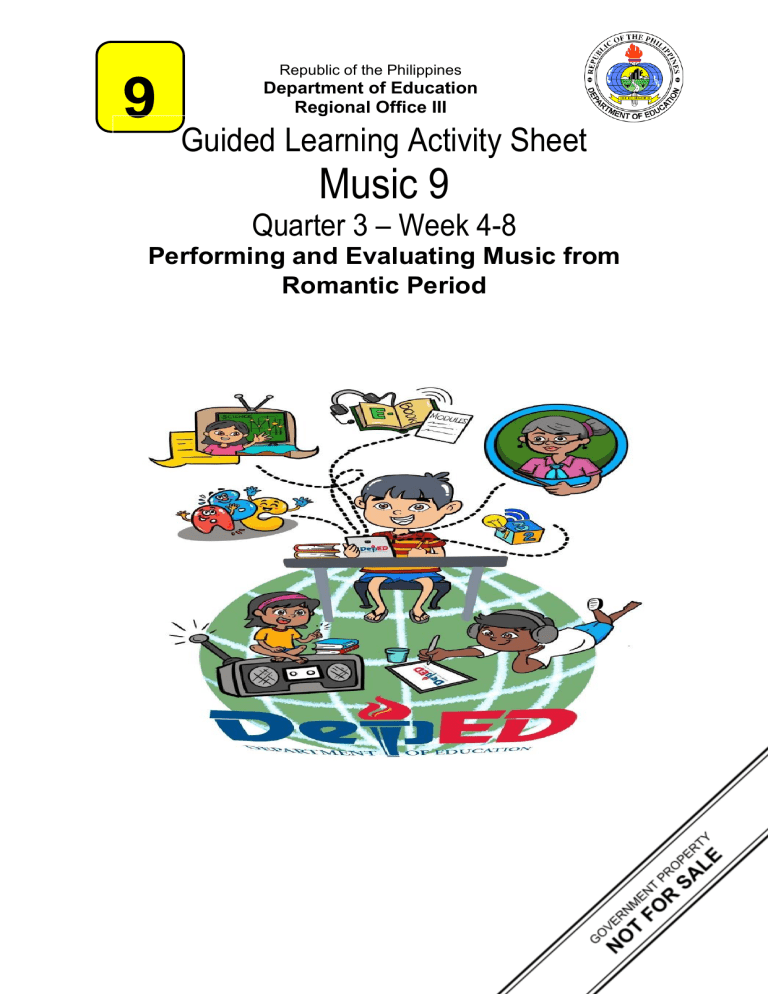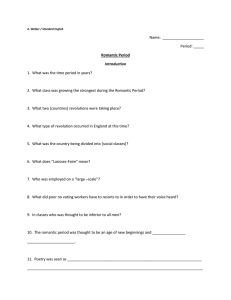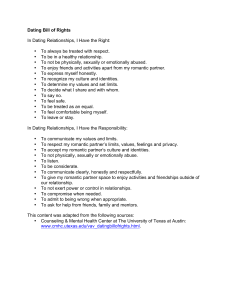
9 Republic of the Philippines Department of Education Regional Office III Guided Learning Activity Sheet Music 9 Quarter 3 – Week 4-8 Performing and Evaluating Music from Romantic Period Music– Grade 9 Guided Learning Activity Sheet Improvising appropriate accompaniment, performing selected music from Romantic period and evaluating music performance using rubrics Quarter 3- Week 4-8 Republic Act 8293, section 176 states that: No copyright shall subsist in any work of the Government of the Philippines. However, prior approval of the government agency or office wherein the work is created shall be necessary for exploitation of such work for profit. Such agency or office may, among other things, impose as a condition the payment of royalties. Borrowed materials (i.e., songs, stories, poems, pictures, photos, brand names, trademarks, etc.) included in this module are owned by their respective copyright holders. Every effort has been exerted to locate and seek permission to use these materials from their respective copyright owners. The publisher and authors do not represent nor claim ownership over them. Guided Learning Activity Sheet Development Team Writer: Carmelo D. Garcia Editors: Reviewer: Graphic Artist:CARMELO D. GARCIA Layout Artist; CARMELO D. GARCIA Layout Evaluator: Cover Designer: Paul Marion R. Vallentos Management Team: May B. Eclar, PhD, CESO III Roda T. Razon ,PhD. CESO V Librada M. Rubio, PhD, Chief-CLMD Ma. Editha R. Caparas, EdD, ESP-LRMS Engelbert B. Agunday Jr. EdD, EPS, MAPEH Rosauro M. Perez EdD, EPS-MAPEH Lily Beth B. Mallari, EPS-LRMS Printed in the Philippines, Department of Education – Central Luzon Office Address : Matalino st. Government Center, Maimpis City of San Fernado Pampanga Telefax (045) 598-8580 to 89 : E-mail Address: region3@deped.gov.ph I. What I Need to Know? Learning Competency At the end of this Guided Learning Activity Sheet, you are expected to: ➢ Improvises appropriate accompaniment to selected music from Romantic Period ( week 4-5 MU9CL-lle-9) ➢ Perform selected music from Romantic period, ( week 6-7 MU9CL-llb-h-7) ➢ Evaluates music and music performance using guided rubrics ( week 8) II. What I Know? Direction: Identify the composers of Romantic Period from each column. 1 2 3 4 5 Johann Sebastian Bach Ludwig Van Beethoven Franz Liszt Richard Wagner Arnold Schoenberg Franz Schubert Robert Schurmann Igor Stravinsky Cammille Saint-Seans Claude Debussy Wolfgang Amadeus Mozart Ryan Cayabyab Ramon Santos Edward Grieg Frederic Chopin LESSON 4-8 Performing and Evaluating Music from Romantic Period III. What’s In? A. Identification: Identify what is being asked. ________________1. He was known as the virtuoso pianist and composer and the busiest musician during the romantic era. ________________2. It is a piece composed for the development of a specific point of technique. ________________3. He started playing mandolin at the age of 5. ________________4. The compositions in this period are more passionate and expressive. ________________5. He developed a problem with his hands, effectively ending his dreams as a pianist. IV. What’s New Direction: Listen to the Link below, Draw your impression on the box while listening to music. Mahler’s Symphony No. 8 in E-Flat major Symphony of a thousand https://www.youtube.com/watch?v=nxf3xtH31jA (Downloaded video will sent through messenger ahead of discussion) V. What is it? Ask most people what they consider a romantic song, and if they familiar with the song “All of Me” by John Legend or most anything about Marvin Gay. But, as you know, the Capital “ R “ in Romantic music is works composed in Romantic style, which arose during the Romantic period At its core, composer of Romantic Era saw music as a means of individuality and expressing of emotion. Indeed, they considered music the art form most capable of expressing the full range of human emotion; as a result, romantic composers broadened 4 the scope of emotional content. The music was expected to communicate to the audience, often by using a narrative form that fold distinct stories. Changes to orchestra during the romantic period is a critical mean to expanding the expressiveness of the music- primarily through tonal colour, broader dynamic and richer harmonies was by increasing the number of instruments required to perform the composition, Example: Mahler’s Symphony No. 8 in E-Flat major Symphony of a thousand https://www.youtube.com/watch?v=nxf3xtH31jA (Downloaded video will sent through messenger ahead of discussion) This requires to choirs and 120 musicians including over 70 string musicians and orchestra from classical era typically had around 30 musicians, the orchestra continued to grow and evolve throughout the Romantic period. Setting into the orchestra we know today. As alluded to above, the wind and brass section grew through the addition of a variety of instruments, such as the Piccolo and contabasson, both of which greatly expanded the tonal rage of music, the percussion section also saw numerous instrument added from the bass drums to get the triangle The string section also expanded. It remained comprised of the same four instruments: Violin, viola, cello and double bass. However, the number of each string instrument increased. Enlarging the number of string allowed for the creation of more subsets within the string section. Romantic composers would use different configurations of small groups of strings to deepen the texture and contrast within a work. Another orchestral innovation of the period was intermittent use of non-traditional instrument. 5 Example: Tchaikovsky’s 1812” Overtune Cannons” https://www.youtube.com/watch?v=0F5k70xwGSk. Image downloaded from google. (Downloaded video will sent through messenger ahead of discussion) An expanded orchestra was needed to perform the longer, more dramatic symphonies from the Romantic Era. While the symphony exploded to new intensity during this time, the period is also notable from composers creating a variety of types of “ miniature” works. Symphonie Fantastique Extremely sensitive and imaginative musician tries to kill himself with opium due to depression caused by discouraged love. Unfortunately, the dose was not enough and does not kill but instead, plunges him into a heavy sleep flocked with nightmares. His experiences, feelings and memories are translated in hallucinations of musical thoughts and images. The girl he loves was transformed into melody and like a recurring theme, he meets and hears everywhere. Each movement of symphony refers to a different vision in the young musicians mind. Movement 1st Movement 6 Title Reveries/ Passion Tempo Largo slow introduction) allegro agitato( has both a tempo indication) e appasionado assai ( agitated and very impassioned Form allegro) 2nd Movement A Ball Allegro non Troppo The movement waltz ABA form second is a 3rd Movement Scene country in the Adagio waltz ( slow ABA Coda Form tempo) 4th Movement March Scaffold to the Allegretto ( fasten Composed of two than andante but different themes not so fast) non troppo 5th Movement Dream of a witches Larghetto allegro ( Most Fantastic of Sabbath slowly with great the movement expression) VI. What’s More? Enrichment Activities Activity 1. Music Concept Rapping Direction: Choose one topic below and perform through Rap style. Record your performance and sent it to your teacher using via messenger. You can use instrumental music as accompaniment for Rap music. Topic 1 Topic 2` Topic 3 Violin and Strings Music Piano Music Program Music Rap/Song Rubric Criteria 7 5 4 3 2 Originality and Presentation Appearance show considerable originality and inventiveness. The content and ideas are presented in a unique and interesting way. Excellent use of graphics and background Presentation shows some originality and inventiveness. The content and ideas are presented in an interesting way. Good use of graphics and backgrounds Presentation shows an attempt at originality and inventiveness. Fair use of graphics and backgrounds. Presentation is reduced attempt at originality ad inventiveness. Reduced use of graphic and backgrounds Content Information is detailed, varied and extensive Includes important interesting information Includes some important and interesting information. Minimal content Audio Quality Singing/ Rapping is clear, with good diction and appropriate words for the topic. Music is at appropriate level. Not too loud or soft and in accordance with singing Audio could be better quality. Music and singing a little out of balance… either music chosen or the singing is slightly too loud but still audible Audio could be better quality. Singing could be articulated better. Music or singing overpower the other, making it difficult but still possible to understand Audio is of very reduced quality (too loud or soft, fuzzy!) Music and singing compete as audio in not properly levelled. Activity 2. Direction: listen the 2nd movement of symphony Fantastique’s “ A Ball”and write down words to describe the atmosphere and emotions. Modular; learner will write their favorite songs and draw the words to describe the atmosphere and emotion, write your answer in a piece of paper. Listening music: https://www.youtube.com/watch?v=npg11G8ZkAY (Downloaded video will sent through messenger ahead of discussion) 8 Symphonie Fantastique Atmosphere and Emotions 2nd movement – a ball Introduction 00:00 – 00:39 Beginning 00:39 – 02:15 Middle 02:16- 05:38 End 05: 39 – 06:38 Moods / Atmosphere Scary, Shocking, Explosive, Mystery, Joy, Cheerful, Friendly, Inviting, Warm, Noble, Serious, Dark, Adventure, Cal/ peaceful , Excitement Symphonie Fantastique Atmosphere / Emotion 2nd movement 00:00 – 00:39 Ex. Scary 00:39- 02:15 02:15- 05:38 05:39- 06:38 VII. What’s I Have Learned? Direction: complete the following unfinished sentence 9 . 1. My understanding about the music of the Roman Period is that…………………… ______________________________________________________________________ ______________________________________________________________________ 2. I realized that most of music from the Romantic Period are…………………………….. ______________________________________________________________________ ______________________________________________________________________ 3. The reason why I appreciate instrumental music from the Romantic period is because………………………………………………………………………………………… ______________________________________________________________________ ______________________________________________-_______________________ 4. I love listening to the Romantic music composition because……………………………. _____________________________________________________________________________________ _____________________________________________________________________________________ VIII. What I can do? Story Telling Direction: Each student will report the life and music of Romantic period through story telling style using voice recorder and send to the teacher through messenger. You can use movement and voice over to introduce the composer you chose. Choices Robert Schumann Franz Liszt Peter ILyich Tchaikovsky Hector Berloiz Frederic Chopin Exemplary Accomplished Developing Beginning 5 4 3 2 Knows the story well; has obviously practiced telling the story; uses no notes; speaks with confidence Knows the story pretty well; some practice; may use notes fairly confident Rubric for Storytelling Criteria Knows the story 10 Knows some of Does not know the story; has story; reads not practiced; from notes relies on notes ; appears uncomfortable Voice Always speaks loudly, slowly, and clearly Correct pronunciation; explain unfamiliar words. Usually speaks loudly, slowly, and clearly correct pronunciation; does not explain the unfamiliar words May speak too softly or too rapidly; mumbles occasionally incorrect pronunciation of some words; does not explain unfamiliar words. Speak too softly or rapidly; mumbles incorrect pronunciation; does not know what unfamiliar words mean Point of view Establishes a purpose early on and maintain clear focus throughout Establishes a purpose early on and maintain focus for most of the presentation. There are few lapses in focus, but the purpose is fairly clear. It is difficult to figure out the purpose of the presentation. Duration Story lasts 5 to 8 minutes Story lasts less than 5 to 8 minutes Story lasts less than 4 or more than 8 minutes Story lasts less than 3 or more than 9 minutes IX. Assessment A. Direction: Instruction: Complete the table below and give the needed information. Movement Title 1st Movement 2nd Movement 11 Form Largo slow introduction) allegro agitato e appasionado assai ( agitated and very impassioned allegro) A Ball 3rd Movement 4th Movement Tempo ABA Coda Form March to the Scaffold 5th Movement Most Fantastic of the movement ANSWER Key: Movement Title Tempo 1st Movement Reveries/ Passion Largo slow introduction) allegro agitato e appasionado assai ( agitated and very impassioned allegro) 2nd Movement A Ball Allegro non Troppo Form ABA form The second movement is a waltz 3rd Movement Scene in the country Adagio waltz ABA Coda Form 4th Movement March to the Scaffold Allegretto non troppo Composed of two different themes 5th Movement Dream of a witches Sabbath Larghetto allegro Most Fantastic of the movement References : https://www.youtube.com/watch?v=npg11G8ZkAY Connollymusic.com https://www.youtube.com/watch?v=0F5k70xwGSk https://www.youtube.com/watch?v=nxf3xtH31jA http://www.classicfm.com www.slideshare.com Music and Arts learners Material. First Edition 2014 12


